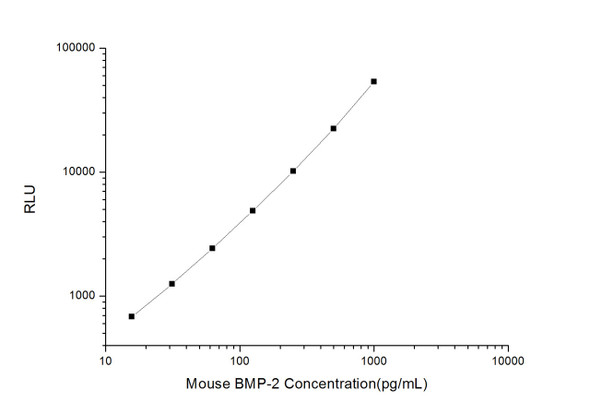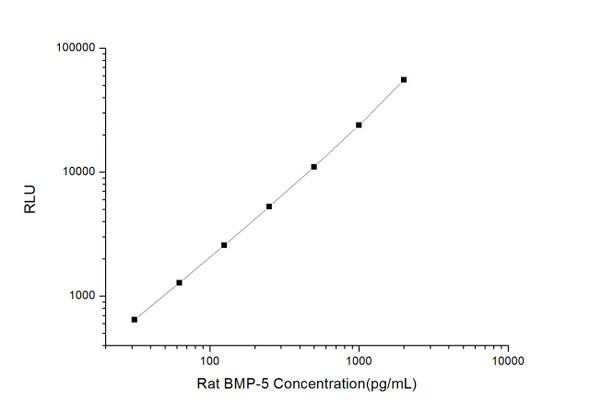Rat Signaling ELISA Kits 2
Rat BMP-2 (Bone Morphogenetic Protein 2) CLIA Kit (RTES00002)
- SKU:
- RTES00002
- Product Type:
- ELISA Kit
- ELISA Type:
- CLIA Kit
- Size:
- 96 Assays
- Sensitivity:
- 9.38pg/mL
- Range:
- 15.63-1000pg/mL
- ELISA Type:
- Sandwich
- Synonyms:
- BMP2A, BMP-2A, BDA2
- Reactivity:
- Rat
- Sample Type:
- Serum, plasma and other biological fluids
- Research Area:
- Cell Biology
Description
| Assay type: | Sandwich |
| Format: | 96T |
| Assay time: | 4.5h |
| Reactivity: | Rat |
| Detection method: | Chemiluminescence |
| Detection range: | 15.63-1000 pg/mL |
| Sensitivity: | 9.38 pg/mL |
| Sample volume: | 100µL |
| Sample type: | Serum, plasma and other biological fluids |
| Repeatability: | CV < 15% |
| Specificity: | This kit recognizes Rat BMP-2 in samples. No significant cross-reactivity or interference between Rat BMP-2 and analogues was observed. |
This kit uses Sandwich-CLIA as the method. The micro CLIA plate provided in this kit has been pre-coated with an antibody specific to Rat BMP-2. Standards or samples are added to the appropriate micro CLIA plate wells and combined with the specific antibody. Then a biotinylated detection antibody specific for Rat BMP-2 and Avidin-Horseradish Peroxidase (HRP) conjugate are added to each micro plate well successively and incubated. Free components are washed away. The substrate solution is added to each well. Only those wells that contain Rat BMP-2, biotinylated detection antibody and Avidin-HRP conjugate will appear fluorescence. The Relative light unit (RLU) value is measured spectrophotometrically by the Chemiluminescence immunoassay analyzer. The RLU value is positively associated with the concentration of Rat BMP-2. The concentration of Rat BMP-2 in the samples can be calculated by comparing the RLU of the samples to the standard curve.
| UniProt Protein Function: | BMP2: Induces cartilage and bone formation. Belongs to the TGF-beta family. |
| UniProt Protein Details: | Protein type:Motility/polarity/chemotaxis; Secreted, signal peptide; Secreted Cellular Component: extracellular space; protein complex; cell surface; cytoplasm; extracellular region Molecular Function:protein domain specific binding; protein homodimerization activity; growth factor activity; protein heterodimerization activity; phosphatase activator activity; cytokine activity; SMAD binding; transforming growth factor beta receptor binding; receptor binding; retinol dehydrogenase activity Biological Process: activation of MAPK activity; positive regulation of apoptosis; heart development; positive regulation of transcription, DNA-dependent; adrenocorticotropin hormone secreting cell differentiation; telencephalon regionalization; protein amino acid phosphorylation; cardiac muscle cell differentiation; regulation of apoptosis; BMP signaling pathway; ovulation cycle; chondrocyte differentiation; inner ear development; regulation of odontogenesis of dentine-containing teeth; positive regulation of astrocyte differentiation; pericardium development; positive regulation of neurogenesis; cell fate commitment; organ morphogenesis; mesenchymal cell differentiation; response to mechanical stimulus; regulation of MAPKKK cascade; positive regulation of osteoblast proliferation; positive regulation of fat cell differentiation; positive regulation of endothelial cell proliferation; positive regulation of transcription from RNA polymerase II promoter; negative regulation of transcription, DNA-dependent; positive regulation of cell differentiation; negative regulation of calcium-independent cell-cell adhesion; positive regulation of odontogenesis; proteoglycan metabolic process; embryonic heart tube anterior/posterior pattern formation; negative regulation of insulin-like growth factor receptor signaling pathway; thyroid stimulating hormone secreting cell differentiation; negative regulation of transcription from RNA polymerase II promoter; bone mineralization; negative regulation of cell cycle; negative regulation of cell proliferation; regulation of transcription, DNA-dependent; positive regulation of MAPKKK cascade; negative regulation of aldosterone biosynthetic process; cardiac muscle morphogensis; inflammatory response; positive regulation of Wnt receptor signaling pathway; cardiac cell differentiation; Notch signaling pathway; ossification; response to retinoic acid; protein destabilization; in utero embryonic development; positive regulation of bone mineralization; positive regulation of ossification; odontogenesis of dentine-containing teeth; osteoblast differentiation; positive regulation of osteoblast differentiation; telencephalon development; ureteric bud branching; cartilage development; response to hypoxia; epithelial to mesenchymal transition; positive regulation of protein amino acid phosphorylation; positive regulation of neuron differentiation; growth; positive regulation of cell migration |
| NCBI Summary: | involved in cellular signaling during limb development; induces bone formation [RGD, Feb 2006] |
| UniProt Code: | P49001 |
| NCBI GenInfo Identifier: | 1345612 |
| NCBI Gene ID: | 29373 |
| NCBI Accession: | P49001. 1 |
| UniProt Related Accession: | P49001 |
| Molecular Weight: | 44,383 Da |
| NCBI Full Name: | Bone morphogenetic protein 2 |
| NCBI Synonym Full Names: | bone morphogenetic protein 2 |
| NCBI Official Symbol: | Bmp2 |
| NCBI Protein Information: | bone morphogenetic protein 2; BMP-2; BMP-2A; bone morphogenetic protein 2A |
| UniProt Protein Name: | Bone morphogenetic protein 2 |
| UniProt Synonym Protein Names: | Bone morphogenetic protein 2A; BMP-2A |
| Protein Family: | Bone morphogenetic protein |
| UniProt Gene Name: | Bmp2 |
| UniProt Entry Name: | BMP2_RAT |
As the RLU values of the standard curve may vary according to the conditions of the actual assay performance (e. g. operator, pipetting technique, washing technique or temperature effects), the operator should establish a standard curve for each test. Typical standard curve and data is provided below for reference only.
| Concentration (pg/mL) | RLU | Average | Corrected |
| 1000 | 53168 54182 | 53675 | 53650 |
| 500 | 21773 23205 | 22489 | 22464 |
| 250 | 10555 9867 | 10211 | 10186 |
| 125 | 4842 4960 | 4901 | 4876 |
| 62.5 | 2494 2412 | 2453 | 2428 |
| 31.25 | 1287 1275 | 1281 | 1256 |
| 15.63 | 677 739 | 708 | 683 |
| 0 | 25 25 | 25 | -- |
Precision
Intra-assay Precision (Precision within an assay): 3 samples with low, mid range and high level Rat BMP-2 were tested 20 times on one plate, respectively.
Inter-assay Precision (Precision between assays): 3 samples with low, mid range and high level Rat BMP-2 were tested on 3 different plates, 20 replicates in each plate.
| Intra-assay Precision | Inter-assay Precision | |||||
| Sample | 1 | 2 | 3 | 1 | 2 | 3 |
| n | 20 | 20 | 20 | 20 | 20 | 20 |
| Mean (pg/mL) | 49.34 | 157.34 | 439.66 | 49.44 | 144.52 | 449.65 |
| Standard deviation | 5.63 | 17.92 | 49.64 | 4.92 | 15.09 | 43.08 |
| C V (%) | 11.41 | 11.39 | 11.29 | 9.95 | 10.44 | 9.58 |
Recovery
The recovery of Rat BMP-2 spiked at three different levels in samples throughout the range of the assay was evaluated in various matrices.
| Sample Type | Range (%) | Average Recovery (%) |
| Serum (n=5) | 95-110 | 100 |
| EDTA plasma (n=5) | 91-104 | 98 |
| Cell culture media (n=5) | 95-109 | 101 |
Linearity
Samples were spiked with high concentrations of Rat BMP-2 and diluted with Reference Standard & Sample Diluent to produce samples with values within the range of the assay.
| Serum (n=5) | EDTA plasma (n=5) | Cell culture media (n=5) | ||
| 1:2 | Range (%) | 97-112 | 85-97 | 104-118 |
| Average (%) | 102 | 92 | 110 | |
| 1:4 | Range (%) | 85-95 | 98-110 | 96-109 |
| Average (%) | 90 | 104 | 103 | |
| 1:8 | Range (%) | 86-101 | 100-115 | 102-116 |
| Average (%) | 93 | 106 | 110 | |
| 1:16 | Range (%) | 83-97 | 95-110 | 87-102 |
| Average (%) | 90 | 101 | 94 |
An unopened kit can be stored at 4°C for 1 month. If the kit is not used within 1 month, store the items separately according to the following conditions once the kit is received.
| Item | Specifications | Storage |
| Micro CLIA Plate(Dismountable) | 8 wells ×12 strips | -20°C, 6 months |
| Reference Standard | 2 vials | |
| Concentrated Biotinylated Detection Ab (100×) | 1 vial, 120 µL | |
| Concentrated HRP Conjugate (100×) | 1 vial, 120 µL | -20°C(shading light), 6 months |
| Reference Standard & Sample Diluent | 1 vial, 20 mL | 4°C, 6 months |
| Biotinylated Detection Ab Diluent | 1 vial, 14 mL | |
| HRP Conjugate Diluent | 1 vial, 14 mL | |
| Concentrated Wash Buffer (25×) | 1 vial, 30 mL | |
| Substrate Reagent A | 1 vial, 5 mL | 4°C (shading light) |
| Substrate Reagent B | 1 vial, 5 mL | 4°C (shading light) |
| Plate Sealer | 5 pieces | |
| Product Description | 1 copy | |
| Certificate of Analysis | 1 copy |
- Set standard, test sample and control (zero) wells on the pre-coated plate and record theirpositions. It is recommended to measure each standard and sample in duplicate. Note: addall solutions to the bottom of the plate wells while avoiding contact with the well walls. Ensuresolutions do not foam when adding to the wells.
- Aliquot 100µl of standard solutions into the standard wells.
- Add 100µl of Sample / Standard dilution buffer into the control (zero) well.
- Add 100µl of properly diluted sample (serum, plasma, tissue homogenates and otherbiological fluids. ) into test sample wells.
- Cover the plate with the sealer provided in the kit and incubate for 90 min at 37°C.
- Aspirate the liquid from each well, do not wash. Immediately add 100µL of BiotinylatedDetection Ab working solution to each well. Cover the plate with a plate seal and gently mix. Incubate for 1 hour at 37°C.
- Aspirate or decant the solution from the plate and add 350µL of wash buffer to each welland incubate for 1-2 minutes at room temperature. Aspirate the solution from each well andclap the plate on absorbent filter paper to dry. Repeat this process 3 times. Note: a microplatewasher can be used in this step and other wash steps.
- Add 100µL of HRP Conjugate working solution to each well. Cover with a plate seal andincubate for 30 min at 37°C.
- Aspirate or decant the solution from each well. Repeat the wash process for five times asconducted in step 7.
- Add 100µL of Substrate mixture solution to each well. Cover with a new plate seal andincubate for no more than 5 min at 37°C. Protect the plate from light.
- Determine the RLU value of each well immediately.






